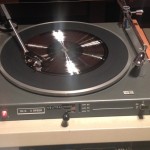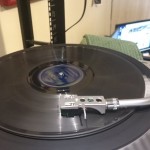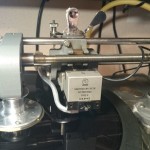Among the tunes I remastered for “Glenn Miller – Swing For the Jukebox” was, of course, “Tuxedo Junction”. I got a DSD copy from the original metal master – but, unfortunately, this more than 70 years old master was severely degraded. Would it be possible to get something out of it?
Tuxedo Junction was introduced by the Erskine Hawkins Orchestra, a college dance band formerly known as the Bama State Collegians. In the late 1930s Hawkins and his Orchestra were one of the house bands at the Savoy Ballroom. They alternated with the Chick Webb band, and often used “Tuxedo Junction” as their sign-off song before the next band would take the stage, so that the dancing would continue uninterrupted. Glenn Miller and His Orchestra had the most successful recording of the song in a best-selling (Billboard Number 1) record, RCA Bluebird B-10612-A. Miller’s arrangement slowed down the tempo and added trumpet fanfares. The infamous trumpet lick in the original recording was played by band member Johnny Best. The Glenn Miller recording sold 115,000 copies in the first week alone. [Wikipedia]

Metal Master Disc being played
There were no reel to reel machines to archive sound back in the days. The live performance was cut into a wax or lacquer record. This master recording was then plated with metals creating the basis from which the pressing forms were taken. For more details on how records are created: Part 1, Part 2 . This first metal disc – the first copy of the initial wax or lacquer record – the so called “metal part” is what we were working with. But – as this record doesn’t have grooves (it has ridges instead of grooves) it needs a special pickup cartridge that rides the ridges – not a needle that runs in the grooves. Battery Studios in New York has that equipment and Matt Cavaluzzo tranferred the sound into a very high resolution DSD file for us. So – our sources were ultra high resolution digital copies of the original metal master. One can’t get closer to the original. But the metal parts are close to 80 years old. Though Matt did a great job – we couldn’t expect a perfect sound.
This is how the original metal master of “Tuxedo Junction” sounds like. As you can imagine, I was crushed. How would I ever be able to get something out of this? The low frequency rumble I would be able to deal with, but the highs were in parts severely distorted and, well, you can’t polish a tur .. tle – as they say in the music restoration business. I would have to replace parts of the higher frequency spectrum while preserving the maximum from the metal master. Question was: With what? Other mastering engineers before me took a shortcut. They limited the higher frequencies and added some reverberation masking the distortions.
This is a copy from a CD – do you notice the reverb? But that was unacceptable for us. We didn’t want to just “fix” the sound, we  wanted to restore it. So – we started to remove the obvious clicks and pops – kudos to Mark Cederquist who manually took care of all the pesky clicks and EQd it really nicely – a great foundation to work with. But we still had those bad upper frequencies. So – we first recorded a few of our own 78rpm copies of “Tuxedo Junction” and took the best to continue to work on. Before the recording, we thoroughly cleaned the records and re-adjusted our record player and the 78rpm cartridge (SHURE M78-S) . Quite frankly – parts of the original 78rpm recorded sounded better than the master.
wanted to restore it. So – we started to remove the obvious clicks and pops – kudos to Mark Cederquist who manually took care of all the pesky clicks and EQd it really nicely – a great foundation to work with. But we still had those bad upper frequencies. So – we first recorded a few of our own 78rpm copies of “Tuxedo Junction” and took the best to continue to work on. Before the recording, we thoroughly cleaned the records and re-adjusted our record player and the 78rpm cartridge (SHURE M78-S) . Quite frankly – parts of the original 78rpm recorded sounded better than the master.
People might think that one just take the captured sound of one source and can overlay it onto another. That’s a good theory – but unfortunately .. it doesn’t work. Both recordings have been copied from mechanical devices and those devices have tiny little variation in speed – called wow and flutter. If you play overlaid versions, you’ll instantly hear “phasing” when sound curves overlap and enhancing or cancelling themselves out. So – I didn’t overlay, but replaced distorted parts of the metal master with clips from the record. To do that, I first removed the bad frequencies from the part of the original I wanted to fix. Than I removed all BUT the frequency band from the same part of the record. Since I replaced the frequencies, there was no phasing. It took about a week to go through the recording, step by step and to find an to replace those small distorted parts that need to be worked on.
After this work, the song went back to Mark for a final review and touch-up. The digital work was done.
 But before we could call it “ready”, I ran it through our analog work-chain to find the right “color” and – for the for the first time in so many years, a remastered “Tuxedo Junction” was once again cut into a 78rpm record. The record was play-tested on our 78rpm system as well as in our restored vintage 1937 Wurlitzer Type 24 jukebox. It played without problems. Inverse RIAA was applied and the record was cut with a micro groove stylus – but I applied a little more weight to the cutting stylus, so that the cut would go slightly deeper widening the groove enough to allow the tracking of a standard groove stylus.
But before we could call it “ready”, I ran it through our analog work-chain to find the right “color” and – for the for the first time in so many years, a remastered “Tuxedo Junction” was once again cut into a 78rpm record. The record was play-tested on our 78rpm system as well as in our restored vintage 1937 Wurlitzer Type 24 jukebox. It played without problems. Inverse RIAA was applied and the record was cut with a micro groove stylus – but I applied a little more weight to the cutting stylus, so that the cut would go slightly deeper widening the groove enough to allow the tracking of a standard groove stylus.
Here’s a taste:
Well – that’s it for that blog-entry. You’ll find samples of all other remastered audios right here. If you have questions or suggestions, feel free to contact me.
